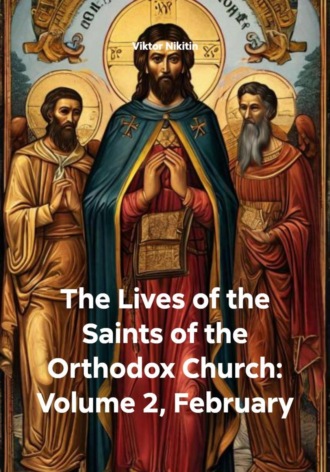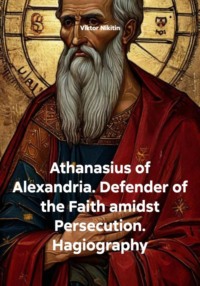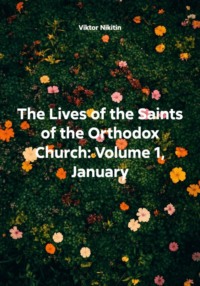
Полная версия
The Lives of the Saints of the Orthodox Church: Volume 2, February
New-Martyr Joseph of Aleppo:
A Syrian Christian martyred for his steadfast refusal to deny Christ. Joseph endured threats, imprisonment, and severe mistreatment, ultimately giving his life in witness to the faith. His memory is honored as an example of courage and unwavering devotion in regions long afflicted by persecution.
Saint George, Prince of Vladimir:
A pious Russian prince from the ruling house of Vladimir. Known for his meekness, charity, and love for the Orthodox faith, he governed with justice and peacefulness. He is remembered more for his virtue and Christian humility than for political achievements. His veneration arose from local devotion to his righteous life and God-pleasing death.
Saint Cyril, Abbot and Wonder-worker of Novoezersk (Novgorod):
Saint Cyril (15th c.) founded the Novoezersk (New Lake) Monastery in the Novgorod region. Known for strict asceticism, humility, and gift of wonderworking, he became a spiritual father to many. Numerous miracles were attributed to him both during his life and after his repose, especially healings and deliverance from danger. His relics became a source of consolation for pilgrims.
Martyr Jadorus:
A little-known early martyr who suffered for confessing Christ. The surviving accounts preserve only the fact of his martyrdom, but his name is kept in the Church’s memory as one of the countless early witnesses whose steadfast faith strengthened the Christian community.
Hieromartyr Abramius, Bishop of Arbela in Assyria:
Bishop Abramius (4th c.) shepherded the Christian community in Arbela (modern Erbil) during times of severe persecution. Arrested for teaching the Gospel, he was tortured and then executed for refusing to offer sacrifice to pagan gods. His martyrdom strengthened the Church in Persia, where Christian life continued under heavy oppression.
Saint John, Bishop of Hirenopolis, one of the 318 Fathers of Nicaea:
Saint John took part in the First Ecumenical Council in 325, defending Orthodox doctrine against the Arian heresy. As bishop of Hirenopolis in Syria, he was known for pastoral dedication, learning, and calm firmness in preserving apostolic teaching. He reposed in peace after decades of service.
Saints Abraham and Coprius, monks of Pechenga (Vologda):
These monastic brothers labored in asceticism in the wilderness around Vologda. They embraced silence, fasting, hard manual labor, and continual prayer. Their humility, obedience, and purity of heart became models for other monks. After a long life of spiritual struggle, both reposed peacefully in the Lord.
Martyr Theoctistus:
One of the early martyrs whose steadfast faith led to death during imperial persecutions. Although few details of his life survive, the Church remembers his courage and his refusal to renounce Christianity even under threat of violent death.
Saint Jasim the Wonder-worker:
A holy ascetic known for quiet humility, deep prayer, and miracles granted through his intercession. His life is only partially preserved in local tradition, but he is commemorated especially for healing the sick and bringing comfort to those suffering spiritual affliction.
Saint Evagrisi, disciple of St. Shio:
A monk of the Georgian Shio-Mgvime tradition, Evagrisi was a devoted disciple of Saint Shio. He lived in strict asceticism, obedience, and silence, inheriting his master’s spiritual grace. His life continued the legacy of the early Georgian desert fathers whose monasteries became centers of holiness and learning.
Saint Theodosios the Righteous:
An ascetic known for his purity, humility, and life of continual prayer. Living either as a hermit or in a small monastic community, he was venerated for his simplicity, peace-bringing spirit, and spiritual discernment. Many came to him for counsel and consolation.
Saint Modan, Abbot of Stirling and Falkirk:
A Scottish saint of the early medieval period. Modan served as abbot and missionary in central Scotland, preaching to local tribes, building churches, and leading monastic communities. He became known as a protector from storms and dangers for travelers and fishermen. His memory remained strong in the regions around Stirling and Falkirk.
Repose of the Royal Recluse Dosithea of Moscow:
Dosithea (18th c.), born of noble lineage and traditionally believed to have royal connections, renounced worldly life and lived as a recluse near Moscow. Hidden from public life and devoted to repentance, she spent her days in prayer and ascetic solitude, receiving many who sought spiritual advice. Her quiet life of humility and self-denial left a lasting mark on Russian spiritual tradition.
* * *
Lives of the Saints Celebrated on February 5
Martyr Agatha of Palermo in Sicily:
The holy virgin-martyr Agatha (3rd c.) was born into a noble Christian family in Sicily. Renowned for her beauty and purity, she dedicated her life to Christ from her youth. During the persecution under Decius, she was arrested for refusing the advances of the pagan prefect Quintianus and for openly confessing her faith. After cruel tortures—including the mutilation of her body—she was miraculously strengthened by an angel. She surrendered her soul to God in prison. Her relics became a source of healing, and she is revered as a protector against fire, earthquakes, and volcanic eruptions.
Saint Polyeuctos, Patriarch of Constantinople:
Patriarch Polyeuctos (956–970) shepherded the Church during the reign of Byzantine emperors Romanus II and Nicephorus Phocas. Known for his firmness, moral integrity, and courage in reproving even imperial misconduct, he defended the purity of the Church and the sanctity of the canons. He confronted emperors respectfully yet boldly, earning widespread veneration. His patriarchate strengthened ecclesiastical order and fostered piety in the empire.
New-Martyr Anthony of Athens:
A Christian from Greece who suffered martyrdom under Ottoman rule. Anthony remained steadfast despite threats, bribery, and torture designed to force him into apostasy. He accepted death rather than deny Christ, becoming one of the many shining New-Martyrs whose witness preserved Orthodox faith under Islamic oppression.
Martyr Theodula of Anazarbus in Cilicia, and with her Martyrs Helladius, Macarius, and Evagrius:
Theodula, a devout Christian woman, was arrested in Cilicia during imperial persecutions. Filled with courage and divine grace, she endured interrogation and tortures without fear, inspiring others by her unwavering confession. Helladius, Macarius, and Evagrius—likewise steadfast—joined her in martyrdom. Together they received the incorruptible crown, becoming examples of communal witness to Christ during a time of widespread suffering.
Saint Theodosius, Archbishop of Chernigov:
Saint Theodosius (1630–1696) served as Archbishop of Chernigov and was distinguished for his humility, ascetic piety, and dedication to pastoral care. He supported monastic revival, promoted education, defended Orthodoxy against heterodox influences, and became known for miracles both during life and after death. His relics, incorrupt, became a source of healing. He is especially beloved in Ukraine and Russia for his gentle wisdom and spiritual charity.
New-Martyrs Matushka Agatha of Belo-Russia, Schemamonk Eugene, and Righteous Paramon:
These righteous sufferers bore witness to Christ in the turbulent years of the 20th century.
– Matushka Agatha, a pious woman of Belarus, endured oppression and harassment for her loyalty to the Church.
– Schemamonk Eugene, a monastic struggler, suffered persecution for his faith, prayer, and monastic steadfastness.
– Righteous Paramon, a layman, preserved his Christian integrity under danger and repression.
All three are remembered as quiet, humble confessors whose endurance in faith stands as a testimony to truth in an age of worldly cruelty.
Martyr Prince Alfred, at Ely:
A noble prince of early England who suffered martyrdom for Christ. His witness is preserved in local tradition: a ruler who upheld Christian righteousness, fell victim to violence for the sake of his faith, and was honored at Ely as a martyr. His life reflects the early sanctity of Anglo-Saxon Christian culture.
Saint Theodosios of the Isle of Skopelos:
An ascetic and wonderworker who lived on the island of Skopelos. Theodosios devoted himself to prayer, fasting, and silence, gaining the love of the islanders for his holiness. Traditions recount miracles, healings, and protection of the island through his intercession. He reposed peacefully and became deeply revered in the region.
Icon of the Most Holy Theotokos "Seeking Out of the Lost":
This icon is associated with the merciful intervention of the Mother of God in the lives of those who have strayed or fallen into despair. Many miracles have been recorded through this icon, especially the recovery of lost persons, the softening of hardened hearts, and consolation for those struggling with sin or grief. It remains a symbol of the Theotokos’ loving search for every lost soul.
Other event – Repose of Righteous Michael, Metropolitan of Serbia:
Metropolitan Michael (19th c.) guided the Serbian Church during a difficult period of political and social change. A defender of Orthodoxy, promoter of education, and advocate for his flock, he endured exile and persecution for opposing unjust state interference. His steadfastness and spiritual courage made him a revered confessor. He reposed in righteousness, leaving behind a legacy of fidelity and pastoral integrity.
* * *
Lives of the Saints Celebrated on February 6
Saint Bucolus (Boukolos), Bishop of Smyrna:
Saint Bucolus was among the earliest bishops of Smyrna and is traditionally considered one of the disciples of the Apostle John. Living in the first century, he shepherded the Christian community in Smyrna during the time of persecution and instability. Known for his gentle and fatherly care, Bucolus preserved the apostolic traditions and helped strengthen the faith of the early Christians, nurturing the flock through prayer, teaching, and example. He is commemorated as a holy hierarch who passed away peacefully in old age.
Martyr Julian of Emesa:
Julian was a devout Christian from Emesa (modern-day Homs in Syria) who suffered martyrdom in the third century during the widespread Roman persecutions. Refusing to deny Christ despite brutal torture, he demonstrated great courage and faithfulness. His steadfastness became an inspiration for Christians in the region and beyond, who venerated him as a holy martyr who overcame suffering by divine grace.
Virgin-Martyr Fausta, and with her Evilasius and Maximus, at Cyzicus:
Saint Fausta was a young Christian virgin who, together with companions Evilasius and Maximus, bore witness to their faith in Christ in the city of Cyzicus (in Asia Minor) during Roman persecutions. All three endured severe torture and martyrdom for refusing to offer sacrifice to pagan gods. Their unwavering faith and purity made them beloved saints in the early Church, venerated especially for their courage and holiness in the face of death.
Virgin-Martyr Dorothy, two sisters Christina and Callista, and Theophilus, at Caesaria in Cappadocia:
These holy virgin-martyrs lived in Caesaria of Cappadocia (modern-day Kayseri, Turkey) during the period of persecution under the Roman emperors. Saint Dorothy, known for her charitable works and steadfast faith, along with her sisters Christina and Callista and the young martyr Theophilus, refused to renounce Christianity. They suffered imprisonment, cruel tortures, and were ultimately executed. Their martyrdom is remembered as a testimony to the purity, courage, and devotion of early Christian women and children.
Virgin-Martyrs Martha and Mary, and their brother Lycarion, in Egypt:
Saints Martha and Mary were sisters who, along with their brother Lycarion, lived pious Christian lives in Egypt during the early centuries of the Church. They were known for their dedication to asceticism, prayer, and charity. Their family was an example of holy living, and they endured persecution for their faith. The siblings were martyred for refusing to sacrifice to pagan idols, exemplifying familial unity in faith and martyrdom.
Saint Photios, Patriarch of Constantinople:
Saint Photios the Great (9th century) was one of the most influential patriarchs and theologians of the Eastern Orthodox Church. Renowned for his extraordinary intellect, learning, and eloquence, he played a critical role in defending Orthodox doctrine against heresies and schisms, including the Filioque controversy and Latin theological innovations. He presided over the Church during a turbulent period, promoted missionary work among the Slavs, and compiled the famous "Bibliotheca," a vast collection of theological and philosophical works. His leadership and writings significantly shaped Byzantine theology and Orthodoxy.
Saints Barsanouphios the Great and John the Prophet, monks of Palestine:
These two monks were ascetics of the Palestinian desert in the 7th and 8th centuries. Barsanouphios was a spiritual father known for his austere monastic discipline and deep humility. John the Prophet was famed for his prophetic gifts and wisdom, guiding many monks and pilgrims seeking spiritual counsel. Their lives of solitude, prayer, and asceticism inspired generations of monastics and contributed to the spiritual flourishing of the Holy Land.
Saint Dorothy, schema-nun of Kashin:
Saint Dorothy of Kashin was a Russian schema-nun who lived a life of strict asceticism, prayer, and self-denial. She embraced the great schema—a monastic vow entailing extreme renunciation and constant prayer—and became renowned for her holiness, miracles, and spiritual guidance to many faithful. Living in the medieval period, her example of deep faith and humility made her a beloved figure in Russian Orthodox spirituality.
Martyrs Faustus, Basil, Silvanus, and the holy martyrs of Darion in Constantinople:
These martyrs suffered for their Christian faith in Constantinople during a time of persecution. Faustus, Basil, and Silvanus, along with other faithful, were arrested, tortured, and executed because they refused to renounce Christianity. Their steadfastness and willingness to die rather than betray their faith strengthened the Christian community and are commemorated for their courage and sacrifice.
Saint John of Thebes, monk:
Saint John was a monk known for his ascetic life and devotion to prayer in Thebes, Egypt. Living in the early centuries of monasticism, he dedicated himself to solitude, fasting, and the pursuit of holiness. His spiritual life served as an example to others in the desert monastic tradition.
Saint James the Ascetic:
Saint James was a holy ascetic known for his rigorous spiritual practices and humility. He lived a life of solitude and prayer, seeking union with God through self-denial and constant vigilance over his thoughts and actions. Revered for his spiritual wisdom, he is remembered as a model of asceticism in the early Church.
Martyr Julian (Ilyan) of Horns, the holy Unmercenary healer:
Saint Julian, known as Ilyan, was both a martyr and a physician who freely offered healing to those in need without payment, hence the title "Unmercenary Healer." He was martyred for his Christian faith, and his healing ministry was seen as a reflection of Christ’s own works. His memory is cherished for both his compassion and his martyrdom.
Saint Arsenius of Ikaltoi of Georgia:
Saint Arsenius was a Georgian monk and scholar of the medieval period, associated with the Ikalto Monastery, a major center of learning and spirituality in Georgia. He is honored for his asceticism, teaching, and contributions to the monastic and cultural life of Georgia.
Saint James of Kyros in Syria:
Saint James was an ascetic monk living in Kyros, Syria, known for his humility, prayerful life, and miracles. His dedication to monastic ideals made him a spiritual beacon in his region.
Saint Mel, Bishop of Ardagh:
Saint Mel was an early Irish bishop and missionary who played a significant role in spreading Christianity in Ireland. Known for his pastoral care and dedication to monastic life, he is revered as a founder of churches and a guide to many Irish Christians.
Saint Vedast, Bishop of Arras:
Saint Vedast was a Frankish bishop in the 6th century who evangelized northern Gaul. Renowned for his miracles, holiness, and leadership, he played a vital role in converting the local population and establishing the Church in that region.
Saint Amand, Bishop of Elnon:
Saint Amand was a 7th-century missionary bishop and founder of monasteries in present-day Belgium and France. His tireless efforts in preaching, healing, and establishing Christian communities earned him the title of Apostle of Flanders.
Other Commemorations:
Repose of Archbishop Theophanes of Poltava, a holy hierarch remembered for his pastoral zeal, spiritual writings, and leadership of the Church in Ukraine.
* * *
Lives of the Saints Celebrated on February 7
Saint Parthenios, Bishop of Lampasacus on the Hellespont:
Saint Parthenios served as the bishop of Lampasacus, a city located near the Hellespont (the Dardanelles strait in modern-day Turkey). Known for his pastoral zeal and firm defense of Orthodoxy, he shepherded his flock during a challenging time of doctrinal disputes and external pressures. His episcopal tenure was marked by humility, wisdom, and dedication to the spiritual welfare of his people.
Saint Luke the Righteous of Hellas (Greece):
Saint Luke was a devout ascetic and righteous man from Hellas (Greece), renowned for his piety and exemplary Christian life. He embraced solitude and prayer, living a life of humility and spiritual warfare against passions. His holiness inspired many in his homeland, and his memory continues to be honored by those seeking to follow his path of righteousness.
1,003 Martyrs of Nicomedia:
This vast group of martyrs suffered in the city of Nicomedia (modern-day Izmit, Turkey) during one of the intense persecutions of Christians under Roman emperors. Their steadfast faith in Christ led to their mass execution, an event that shocked the early Church and served as a powerful witness to the unbreakable resolve of the faithful. Their collective sacrifice is commemorated as a testament to the power of faith in the face of overwhelming persecution.
Six Martyrs of Phrygia:
These holy martyrs from the region of Phrygia in Asia Minor endured suffering and death for refusing to renounce Christianity. Though their individual names have not all been preserved, their united witness reflects the widespread spread of the faith and the cost borne by early Christians throughout the Roman Empire.
Saint Peter of Monovatia, monk:
Saint Peter was a monk known for his asceticism and spiritual depth in the Monovatia monastery. Living a life of prayer, fasting, and humility, he became a spiritual father to many monks and laypeople. His teachings and example helped to strengthen monastic life in his region.
Martyrs Theopemptus and Synodia:
Saints Theopemptus and Synodia were a married couple who became martyrs for the Christian faith. Their joint witness is a profound example of conjugal sanctity and mutual support in suffering for Christ. They were arrested for their faith, endured torture, and were ultimately put to death, inspiring many believers to remain steadfast.
Saint Aprionos, Bishop of Cyprus:
Saint Aprionos served as bishop in Cyprus during the early centuries of the Church. He is remembered for his pastoral care, zeal for the faith, and leadership in guiding the Christian community through trials and growth. His episcopacy strengthened the Church on the island and set foundations for future generations.
New-Martyr George of Crete:
Saint George of Crete was a martyr during the period of Ottoman oppression, refusing to renounce Christ despite brutal persecution. His witness became a source of hope and courage for the Orthodox Christians living under difficult circumstances on the island of Crete.
Saint Sabba of Kalymnos:
Saint Sabba was a monk and ascetic from the island of Kalymnos in the Aegean Sea. Known for his deep prayer life and miracles, he contributed to the spiritual renewal of the local Christian community and became a model of monastic holiness in the region.
Saint Mastridia of Jerusalem, woman ascetic of the desert (ca. 580):
Saint Mastridia lived in the deserts near Jerusalem, dedicating her life to prayer, fasting, and ascetic struggle. As a woman ascetic in the early Byzantine period, she demonstrated remarkable courage and spiritual strength, inspiring both men and women to pursue holiness through withdrawal and communion with God.
Saint Euthymius, monk of Glinsk Hermitage (1866):
Saint Euthymius was a revered monk at the Glinsk Hermitage in Russia, known for his strict asceticism, humility, and spiritual gifts. Living in the 19th century, he was a spiritual guide for many, renowned for his prayers, healing, and wisdom in the monastic tradition.
New Hieromartyr Barlaam (Ryashentsev), Archbishop of Perm (1942):
Archbishop Barlaam was a leading hierarch in the Russian Orthodox Church who suffered martyrdom under the Soviet regime. Arrested for his faith and leadership, he endured imprisonment and ultimately gave his life for Christ, becoming a symbol of steadfastness in the face of totalitarian oppression.
Hieromartyr Vladimir, Metropolitan of Kiev (see January 25):
Saint Vladimir, the Great Prince of Kiev, is remembered as the Christianizer of Kievan Rus’. His martyrdom is commemorated on January 25, but his spiritual influence extends far beyond that date. He embraced Orthodox Christianity and led his people into the Church, becoming a foundational figure in Slavic Christian history.
Hieromartyr Augulos, Bishop of Augusta, and Martyrs Anatolios, Andreas, Ammon, Statian, Nepotian, Saturninos, Lukios, and Saturna:
Saint Augulos was bishop in Augusta (modern-day Autun, France), martyred along with his companions for refusing to renounce their faith during Roman persecutions. Their witness inspired Christians across Gaul and remains a testament to the strength of early Christian communities in Western Europe.
Saint Ronan, Bishop of Kilmaronen:
Saint Ronan was a missionary bishop credited with spreading Christianity in parts of Ireland and Scotland. Known for his evangelistic zeal and miracles, he is often remembered as a holy man whose influence helped establish the Christian faith among the Celtic peoples.
Saint Richard, father of Saints Willibald, Wunnibald, and Walburga (February 25):
Saint Richard was a nobleman and devout Christian known primarily as the father of three saints: Willibald, Wunnibald, and Walburga. He raised his children in the Christian faith, encouraging their vocations to monastic and missionary work, thus contributing indirectly to the spread of Christianity in Germany and England.
Saint Romuald, Abbot of Ravenna:
Saint Romuald was a Benedictine monk who founded the Camaldolese order, combining eremitic and cenobitic monasticism. Living in the 10th-11th centuries, he sought a life of radical asceticism and reform, establishing monasteries across Italy. His efforts revitalized monastic spirituality and emphasized strict solitude, prayer, and obedience.
King Richard of Wessex:
King Richard of Wessex was a Christian ruler remembered for his just governance and support of the Church. His reign helped to consolidate Christianity in the Anglo-Saxon kingdoms, fostering peace and the building of churches and monasteries.
Other events:
Repose of Archimandrite Gennadius, ascetic of the Roslavl forests:
Archimandrite Gennadius was a modern ascetic who lived in the forests near Roslavl, Russia. Renowned for his strict monastic discipline, humility, and deep prayer life, he was a spiritual father to many and left a legacy of holiness and monastic renewal in the region.
* * *
Lives of the Saints Celebrated on February 8
Great-martyr Theodore Stratelites ("the General"):
Saint Theodore Stratelites was a high-ranking military commander (the term Stratelites means “the General”) in the Roman army during the early 4th century. Despite his position, Theodore openly confessed his Christian faith in an era of intense persecution under Emperor Licinius. Renowned for his piety, humility, and miraculous deeds, he became a beacon of hope for Christians. Arrested for refusing to offer sacrifice to pagan gods, he endured severe tortures, including whipping and imprisonment, but remained unwavering. His miracles include healings and protection of the faithful from harm. Ultimately, he was beheaded for Christ, sealing his witness with his blood. Saint Theodore’s feast celebrates not only his courage but also his role as a heavenly protector, often invoked by soldiers and those facing spiritual battles.











